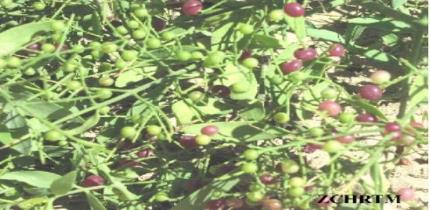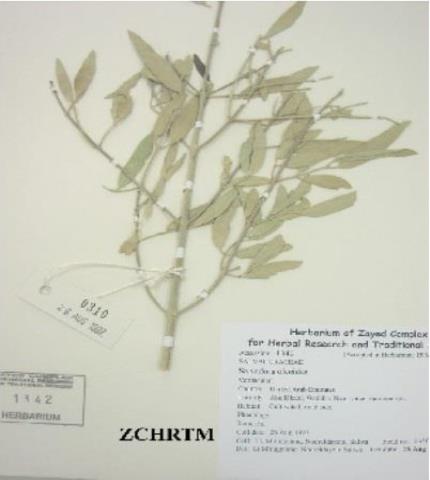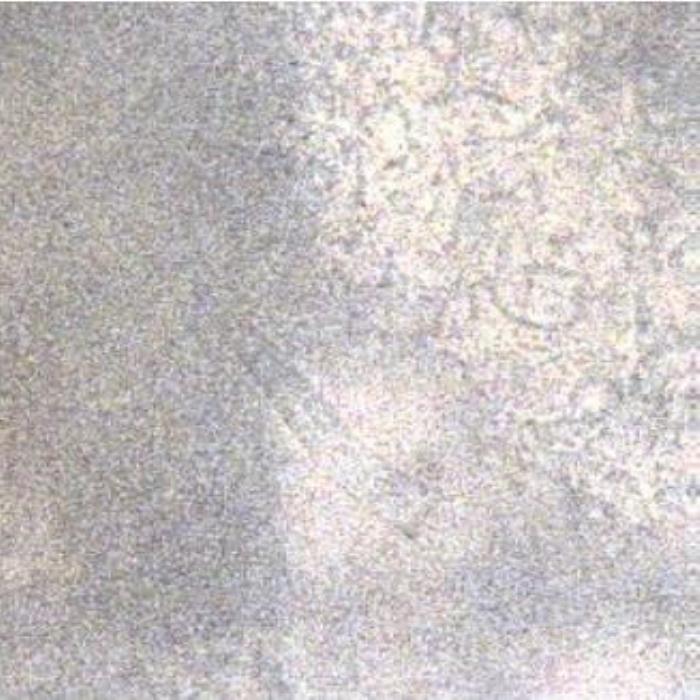
Salvadora persica / السواك
Arak, Miswak, Souwak, Seawak,Lushlush
Toothbrush tree
Rak, Souwak
Salvadoraceae

Fruits

Leaves

Herbarium Sample
Ethnobotanical Characteristics
Description
Large shrub with opposite branches,3 m high sometimes growing as dense thickets on sand hummock. Leaves leathery, elliptical to broadly lanceolate, entire, acute or obtuse,2-5 cm long, 1-2cm wide, on petioles 5 mm long. Flowers 3mm long, in paniculate racemes, on 1-2 mm long pedicles. Fruits globular, berry, fleshy, reddish,3- 6 mm in diameter.
Habitat & Distribution
The plant is widely distributed from Africa through Arabia to china. In UAE found native in few places but widely cultivated in farms and along street as wind barriers.
Part(s) Used
Shoots, Roots and fruits
Traditional & Medicinal Uses
The plant is mentioned in holy Quran and Sonnah, and the roots and shoot sticks have been used for centuries as oral hygiene tools in many parts of the world. It was reported that fresh and dried leaves, dried fruits and stems are used to treat swellings, ulcers and blisters, scorpion stings, regulating menstruation, gases and worms. In UAE the roots used as toothbrushes and the crushed leaves used with oil to treat joint and knee pains while the fruits also are edible. The plant is used in many countries ; fruits edible and used as a carminative, anthelmintic, vulnerary, stomachic, antiseptic and anti inflammatory and good for spleen, gum, scabies, syphilis, gonorrhea and the fruit edible as appetizer. Leaves and flowers used for toothache, gum problems, joint pains, skin diseases snake bites, kidney stones, constipation, as antidote carminative and anthelmintic. The plant broused by cheeps & goats and the leaves used as fodder and a purgative for camels. Also the plant has been incorporated into commercially available toothpaste.
Pharmacognosy and Phytochemistry
Parts studied
Leaves
Microscopic Description
The leaf is unilateral. Both epidermises compose of small polygonal cells and the upper epidermis is covered with a raised thick striated cuticle. Both epidermises bear many unicellular conical covering trichomes of different sizes and they are easily detachable. The stomata are oval and they are very small in size and of the paracytic type. They are distributed on the lower epidermis. The upper epidermis is underlain by a hypodermis which is composed of large broad cells having thick cell walls. The hypodermis is discontinuous and it is interrupted by one or two layers of palisade tissues of different sizes having wavy cells walls. All cells are fairly rich in chlorophyll and granular structures of various shapes including greenish cluster crystals. The spongy tissues compose of large cells of irregular shapes. They also contain granular structures and they embed a group of adjacent sclereids with angular shapes and thick pitted cell walls. The spongy tissues are also traversed by vascular tissues that contain reticulately and spirally thickened vessels and pitted tracheids (DPS, ZCHRTM unpublished results).

a) Lower epidermis

b) Portion of leaf

c) Upper epidermis
- a). Surface view of the lower epidermis showing small polygonal cells and only one small oval stoma is detected and it is of the paracytic type.
- (b). A portion of the leaf showing the lower epidermis in a surface view and a typical detached conical covering trichome.
- (c). Surface view of a portion of the leaf showing the upper epidermis with polygonal cells and a stoma. (Magnifications: All x 400).
Organoleptic characteristics
Appearance: Solid powder
Colour: Light yellowish brown
Odour: Aromatic
Taste: Acrid
Physicochemical constants
Loss in weight on drying at 105°c (%): 10.-10.60
Solubilities( % )
Alcohol solubility: 4.80
Water solubility: 40.0-41.60
10% ethanolic extractive: 45.00
Ash values (%)
Total ash: 25.80-26.60
Water soluble ash: 6.20-6.60
Acid-insoluble ash: 3.60-4.30
Successive extractive (%)
Petroleum ether (60-80°c): 2.60
Chloroform: 1.30
Absolute alcohol: 10.6-12.10
Distilled water: Not done
pH values
pH of 1% solution: 5.84
pH of 10% solution: 5.45
The above results are under process of publication (DPS ZCHRTM unpublished results).
Chemical constituents
Carbohydrates, alkaloid (salvadorine), steroids, terpenoids, saponins, flavonoids (quercetin & kaempferol) and glycosides (Kaempferol 3-, L rhamnosyl-7, xylopyranoside) are present. Kaempferol and quercetin glycosides were confirmed by the hydrolysis of isolated glycosides and co- TLC of their aglycones with authentic samples using benzine, pyridine & formic acid (36:9:5) as mobile phase. (Kamil et.al 1999 a, b, c ; 2000 a, b)
Pharmacological and Toxicological studies
The plant stem extracts on the potentiation of sodium pentobarbitone activity and on generalized tonic-clonic seizer produced by pentaylenetetrazole (PTZ) on rat and and also on extended sleeping time and decreased induction time induced by sodium pentobarbitone (Monforte et. al., 2002) The plant has adverse effect on male and female reproductive system and fertility (Darmani et. al., 2003). Volatile oil extracted from Salvadora persica L. leaves, showed antibacterial effect on several different oral aerobic bacteria (Al-Ali and Al-Lafi, 2003). The aqueous extract of S. persica found in Pakistan and other Asian countries showed antimicrobial activity (Almas, 2001). The plant showed antimycotic effect (Al-Bagieh et. al., l994). S. persica decoction was able to reduce cholesterol and LDL plasma levels. Mice injected with S. persica extract also showed a significantly lower number of stereotype movements of the mice. Stems of S. persica reduced cholesterol and LDL plasma levels. However experiments or HDL and triglycerides were unchanged (Galati et. al., l999). The plant extract possessed significant protective action against ethanol and stress induced ulcers (Sanogo et. al., l999).
The pharmacological and toxicological studies carried out in our laboratory and the results in brief, on Salvadora persica (10% ethanolic extract) have been given below. The results presented without references showed unpublished data (unpublished results, ZCHRTM, DBMS):
|
ACTIVITY |
RESULTS |
|
Anti-inflammatory activity-Rat paw oedema |
Salvadora extract, at both doses showed significant anti-inflammatory activity in rats paw oedema model (Zakaria et al., l998). |
|
Anti-inflammatory activity-Cotton pellet |
Salvadora extract, at both doses showed significant anti-inflammatory activity in cotton pellet mode (Zakaria et al., l998). |
|
Antinociceptive activity-Hot plate |
Extract did not show analgesic activity (Zakaria et al., l998). |
|
Antinociceptive activity-Tail flick |
Extract did not show analgesic activity (Zakaria et al., l998). |
|
Studies on gastric ulcers- Phenylbutazone induced |
Extract produce gastroprotective activity (Islam et. al., 1998). |
|
Studies on gastric ulcers- Indomethacin Induced |
Extract produce gastroprotective activity (Islam et. al., 1998). |
|
Studies on gastric ulcers-NaOH induced |
Extract produces gastroprotective activity (Islam et. al., 1998). |
|
Studies on gastric ulcers-Ethanol induced |
Extract produce gastroprotective activity (Islam et. al., 1998). |
|
Studies on gastric ulcers-Ethanolinduced |
Extract produce gastroprotective activity (Islam et. al., 1998). |
|
Thermocautery-induced ulcers |
Extract produces gastroprotective activity |
|
Anti-secretary activity-Gastric acidity |
No anti-secretary activity was observed (Islam et. al., 1998). |
|
Anti-diabetic activity-STZ |
Extract did not show any effect on blood glucose levels in STZ-diabetic mice. |
|
Diuretic activity |
Extract did not show diuretic activity. No significant change were observed in urine out put electrolytes. |
|
Anti-hypertension activity- Anesthetic rats |
Extract significantly increased blood pressure. No significant effect on the heart rate was found (Radhakrishnan et. al., 1998). |
|
Locomotor activity |
Extract reduced locomotor activity at various period of treatment. |
|
Cardiotonic activity & HR- isolated rat atria |
Produced a dose dependently persistent increase in force of contractions of the isolated atria. No significant change in heart rate was observed (Zakaria et. Al., l998). |
|
Skeletal muscle relaxing activity- Phrenic nerve-diaphragm |
Extract did not block the electrically stimulated contraction of diaphragm. |
|
Anti-asthmatic activity-Tracheal chain of Guinea pig |
Extract did not cause any relaxation of histamine pre-contracted tracheal chain. |
|
Acute toxicity studies |
Lower doses studied did not show signs of toxicity but higher doses produced toxic effect and recorded mortality (Islam, et. al., 2000). |
|
LD50 evaluation |
3650 mg/kg. (Islam, et. al., 2000). |
|
Haematological and Biochemical studies |
Biochemical parameters were remained unchanged. However, serum urea slightly increased and Na and P showed a slight increase (Islam, et. al., 2000). |
|
Teratogenicity |
No teratogenic effect was observed (Islam, et. al., 2000). |
|
Mutagenicity |
No mutagenic effect was observed with the model tested (Islam, et. al., 2000). |
Summary of the results
The plant showed anti-inflammatory activity, increased force of contraction of rat atria in vitro; varying degree of gastric protection; no analgesic activity and antidiabetic activity was observed. Toxicity studies were also carried out.
Microbiological studies
A marked reduction of Streptococcus faecalis and Streptococcus mutans groups and Candida albicans (Almas et al.,2004; Alali et al., 2003; Almas,1999; Al-Bagieh et al., 1994 ). The reduction of streptococcus mutans was significantly greater using miswak in comparison to toothbrushing (p = 0.013), and there was no significant difference for lactobacilli reduction (p = 0.147). It may be concluded miswak has an immediate antimicrobial effect. Streptococcus mutans were more susceptible to miswak antimicrobial activity than lactobacilli. Dietary intake of sugar and oral health status may be considered for controlled clinical trials with special emphasis on the antibacterial activity of miswak on cariogenic bacteria for a longer period of time. It was found that the extract of the leaves has a considerable antibacterial effect on several different oral aerobic bacteria with comparable results to known antibiotics. The extract can be used effectively as a natural tool for teeth cleaning and as a natural analgesic for the disturbing toothache.
References
- Al-Ali F, Al-Lafi T. GC-MS (2003) Analysis and bioactivity testing of the volatile oil from the leaves of the toothbrush tree Salvadora persica L. Nat Prod Res. 17(3): 189-94.
- Alami,R.& Macksad, A medicinal plant of Kuwait. Al –assriya Printing Press ,Kuwait.
- Al-Bagieh NH, Idowu A, Salako NO. ( 1994) Effect of aqueous extract of miswak on the in vitro growth of Candida albicans. Microbios. 80(323): 107- 13.
- Almas K. The antimicrobial effects of extracts of Azadirachta indica (Neem) and Salvadora persica (Arak) chewing sticks. Indian J Dent Res. 1999; 10(1): 23-6.
- Almas K, Al-Zeid Z. The immediate antimicrobial effect of a toothbrush and miswak on cariogenic bacteria: a clinical study. J Contemp Dent Pract. 2004; 5(1):105-14.
- Andrews, F.W. The Flowering Plants of Anglo-Egyptian Sudan; (1950&1952) vol 1+II; Arbroath, Scotland.
- Batanouny,K.H. et al, Wild Medicinal Plants in Egypt: an Inventory to Support Conservation and Sustainable Use. (1999) Palm Press, Egypt, ISBN 977 5089 24 7.
- Chevallier , A. The Encyclopedia of Medicinal Plants. (1996) Dorling Kindersley Limited, London. ISBN 0 7513 03143.
- Darmani H, Al-Hiyasat AS, Elbetieha AM, Alkofahi A. (2003) The effect of an extract of Salvadora persica (Meswak, chewing stick) on fertility of male and female mice. Phytomedicine. 10(1): 63-5.
- Department of Biomedical Sciences, Zyed Complex for Herbal Research and Traditional Medicine, Unpublished results.
- Department ofPharmacognostic Sciences , Zyed Complex for Herbal Research and Traditional Medicine, Unpublished results.
- El-Ghonemy, A. A. Encyclopedia of Medicinal Plants of the United Emirates. (1993) 1st Edition, University of UAE.
- Galati EM, Monforte MT, Forestieri AM, Miceli N, Bader A, Trovato A, Bade A. (1999) Salvadora persica L.: hypolipidemic activity on experimental hypercholesterolemia in rat. Phytomedicine. 6(3): 181-5.
- Ghazanfar, S. A. Handbook of Arabian Medicinal Plants.(1994) Library of Congress.
- Islam, M.W., M.N.M. Zakaria, R. Radhakrishnan, M. Habibullah and K. Chan. Anti- gastric ulcer and cytoprotective effects of Arak tree (Salvadora persica) in rats. 46th Annual Congress of the Society for Medicinal Plant Research, 31 Aug – 4 Sept 1998, Vienna; Abstract no. J55
- Jongbloed, M.V. The Comprehensive Guide to the Wild Flowers of the united Arab Emirates, Erwda, (2003) Emirates Printing Press, Dubai, U.A.E.
- Kamil M , Jayaraj AF, Ahmad F, Gunasekhar C, Samuel S, Habibullah M & Chan K. A Rare Natural Product from Salvadora Persica Leaves. “ 2000 Years of Natural Products Research Past, Present and Future ” July 1999, Amsterdam. P 562.
- Kamil M , Jayaraj AF, Ahmad F, Gunasekhar C, Samuel S, Habibullah & Kamil M , Jayaraj AF, Ahmed F, Gunasekhar C, Samuel S, Habibullah M & Chan K. Use of High-speed counter current chromatography for separation of flavonol glycoside from the leaves of Salvadora persica. The Mona symposium (2000)- Natural Products and Medicinal Chemistry, University of West Indies, Mona Kingston, Jamaica, Jan. 2000.
- Kamil M , Jayaraj AF, Ahmad F, Gunasekhar C, Samuel S, Habibullah M & Chan K. Isolation and Identification of a Flavonol Glycoside using High speed counter current chromatographic Technique from the leaves of Salvadora persica .Pakistan Journal of Scientific and Industrial Research , 2000 , 43, No.4: 225-227.
- Kamil M , Jayaraj AF, Ahmed F, Gunasekhar C, Samuel S, Habibullah M & Chan K. Pharmacognostic and Phytochemical studies on Salvadora persica L. Journal of Pharmacy and Pharmacology, 1999 ,51,Supp: 227. Kamil M, et al. Pharmacognostic and Phytochemical studies on Salvadora Persica L. Hamdard Medicus, Karachi, 1999,Vol. XLII, No. 3 : 64-75 .
- Kotb, T. F. Medicinal Plants in Libya.(1985) Arab Encyclopedia House. Tripoli-Libya.
- Mandaville, J. P. Flora of Eastern Saudi Arabia. (1990) Kegan Paul International Ltd. England.
- Miller A.G., Morris M. Plants of Dhofar, The southern Region of Oman: Traditional, Economic and Medicinal Uses.(1987) Office of the Advisor for conservation of the Environment, Sultanate of Oman.
- Monforte MT, Trovato A, Rossitto A, Forestieri AM, D'Aquino A, Miceli N, Galati EM. (2002) Anticonvulsant and sedative effects of Salvadora persica L. stem extracts. Phytother Res. 16(4):395-7.
- Radhakrishnan, R., M.N.M. Zakaria, M.W. Islam, A. Ismail, M. Habibullah and K. Chan. Effects of Salvadora persica extract on the cardiovascular system of the rat. 46th Annual Congress of the Society for Medicinal Plant Research, 31 Aug – 4 Sept 1998, Vienna ; Abstract no. J56.
- Sanogo R, Monforte MT, Daquino A, Rossitto A, Maur DD, Galati EM. (1999) Antiulcer activity of Salvadora persica L.: structural modifications. Phytomedicine. 6(5): 363-6.
- Western, A. R.The Flora of United Arab Emirates, an introduction. (1986) Publication of the UAE University.
- Zakaria, M.N.M., M.W. Islam, R. Radhakrishnan, A. Ismail, M. Habibullah and K. Chan. Anti-inflammatory properties of Salvadora persica. 46th Annual Congress of the Society for Medicinal Plant Research, 31 Aug – 4 Sept 1998, Vienna; Abstract no. J54.
